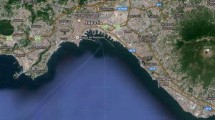Abstract
This paper aims to analyze the impacts of replacing the propulsion technology of small-scale maritime transportation, which currently uses internal combustion engines and may be required to be replaced by electrical propulsion. This analysis has been performed through a qualitative and quantitative assessment of socio-environmental impacts of the replacement proposal. The methodology followed for estimating the impacts of using both types of engines was to adopt a graded scale and a cause-effect matrix. This methodology allowed relating the activities of both types of propulsion with social and environmental factors. The evaluation of the socio-environmental impacts showed that electrical engines generate 2.8 times less impact if compared with combustion engines due to pollution reduction mainly. Consequently, it was possible to highlight the environmental benefit that the implementation of electric engine generates in small-scale maritime transport.



Similar content being viewed by others
References
Antal M, Van den Bergh JC (2013) Macroeconomics, financial crisis and the environment: Strategies for a sustainability transition. Environ Innov Soc Trans 6:47–66. https://doi.org/10.1016/j.eist.2013.01.002
Canter LW, Kamath J (1995) Questionnaire checklist for cumulative impacts. Environ Impact Assess Rev 15(4):311–339
Cashmore M (2004) The role of science in environmental impact assessment: Process and procedure versus purpose in the development of theory. Environ Impact Assess Rev 24(4):403–426. https://doi.org/10.1016/j.eiar.2003.12.002
Danulat E, Edgar GJ (Eds.) (2002) Reserva Marina de Galápagos: línea base de labiodiversidad. Fundación Charles Darwin and Servicio Parque Nacional Galápagos, Santa Cruz, Ecuador. Available online at: http://www.darwinfoundation.org/files/library/pdf/RMG-Linea-Base-Bio.pdf. (in Spanish)
Clark BD, Gilad A, Bisset R, Tomlinson P (2012) Perspectives on Environmental Impact Assessment: Proceedings of the Annual WHO Training Courses on Environmental Impact Assessment, Centre for Environmental Management and Planning Springer Science & Business Media
Conesa V (2009) Guía Metodológica para la Evaluación del Impacto Ambiental (cuarta ed.). Ediciones Mundi-Prensa, Madrid (in Spanish)
Espinoza GA (2002) Gestión y fundamentos de evaluación de impacto ambiental. BID/CED
Faour G, Fayad A (2014) Water environment in the coastal basins of Syria - assessing the impacts of the war. Environ Process 1(4):533–552. https://doi.org/10.1007/s40710-014-0043-5
Fernández-Vítora VC (2009) Guía metodológica para la evaluación del impacto ambiental. Mundi-Prensa Libros, Madrid (in spanish)
Glasson J, Therivel R, Chadwick A (2012) Introduction to Environmental Impact Assessment, Fourth Edi. Routledge, New York
Greig LA, Duinker PN (2011) A proposal for further strengthening science in environmental impact assessment in Canada. Impact Assess Proj Apprai 29(2):159–165
Leopold LB, Clarke FE, Hanshaw BB, Balsley JR (1971) A Procedure for Evaluating Environmental Impact. Geological Survey Circular 645, U.S. Geological Survey, United States Department of the Interior, Washington D.C.
Martínez-Gómez J, Ibarra D, Villacis S, Cuji P, Cruz PR (2016) Analysis of LPG, electric and induction cookers during cooking typical Ecuadorian dishes into the national efficient cooking program. Food Policy 59:88–102. https://doi.org/10.1016/j.foodpol.2015.12.010
Mexiquense EC, González ME, Luís A, Peralta Gallegos JC, Troyo Diéguez E, Ortega Rubio A (2006) Evaluación de impacto ambiental del sector eléctrico en el norte de México. Evolución histórica e implicaciones para la sostenibilidad 6:219–263 (in spanish)
Morgan RK (2012) Environmental impact assessment: the state of the art. Impact Assess Proj Apprais 30(1):5–14
Muñoz M, Herrera I, Lechón Y, Iglesias Martínez E (2015) Life Cycle Sustainability Assessment of electricity from Straight Jatropha Oil Ecuadorian case. 7th International Conference on Life Cycle Management. Bordeaux 2015, August 30–September 02. 1
Petts J (1999) Handbook of Environmental Impact Assessment Volume 2: Environmental Impact Assessment in practice: Impacts and limitations. Black Science
Pinto R, da Conceição Cunha M, Roseta-Palma C, Marques JC (2014) Mainstreaming sustainable decision-making for ecosystems: integrating ecological and socio-economic targets within a decision support system. Environ Process 1(1):7–19. https://doi.org/10.1007/s40710-014-0006-x
Sengers F, Raven R (2015) Toward a spatial perspective on niche development: The case of Bus Rapid Transit. Environmental Innovation and Societal Transitions 17:166–182
Uherek E, Halenka T, Borken-kleefeld J, Balkanski Y, BerntsenT BC, Gauss M, Hoor P, Juda-Rezler K, Lelieveld J, Rypdal K, Schmid S, Melas D (2010) Transport impacts on atmosphere and climate: Land transport. Atmos Environ 44(37):4772–4816
Viana M, Hammingh P, Colette A (2014) Impact of maritime transport emissions on coastal air quality in Europe. Atmos Environ 90:96–105
Villacís S, Martínez J, Riofrío AJ, Carrión DF, Orozco MA, Vaca D (2015) Energy efficiency analysis of different materials for cookware commonly used in induction cookers. Energy Procedia 75:925–930. https://doi.org/10.1016/j.egypro.2015.07.252
Villacreses G, Gaona G, Martínez-Gómez J, Jijón DJ (2017) Wind farms suitability location using geographical information system (GIS), based on multi-criteria decision making (MCDM) methods: The case of continental Ecuador. Renew Energy 109:275–228. https://doi.org/10.1016/j.renene.2017.03.041
Wathern P (2013) Environmental Impact Assessment: Theory and Practice. Routledge. Taylor & Francis, London and New York, pp 1–332
Author information
Authors and Affiliations
Corresponding author
Rights and permissions
About this article
Cite this article
Villacreses, G., Salinas, S.S., Ortiz, W.D. et al. Environmental Impact Assessment of Internal Combustion and Electric Engines for Maritime Transport. Environ. Process. 4, 907–922 (2017). https://doi.org/10.1007/s40710-017-0270-7
Received:
Accepted:
Published:
Issue Date:
DOI: https://doi.org/10.1007/s40710-017-0270-7




